12 September, 2023
windows
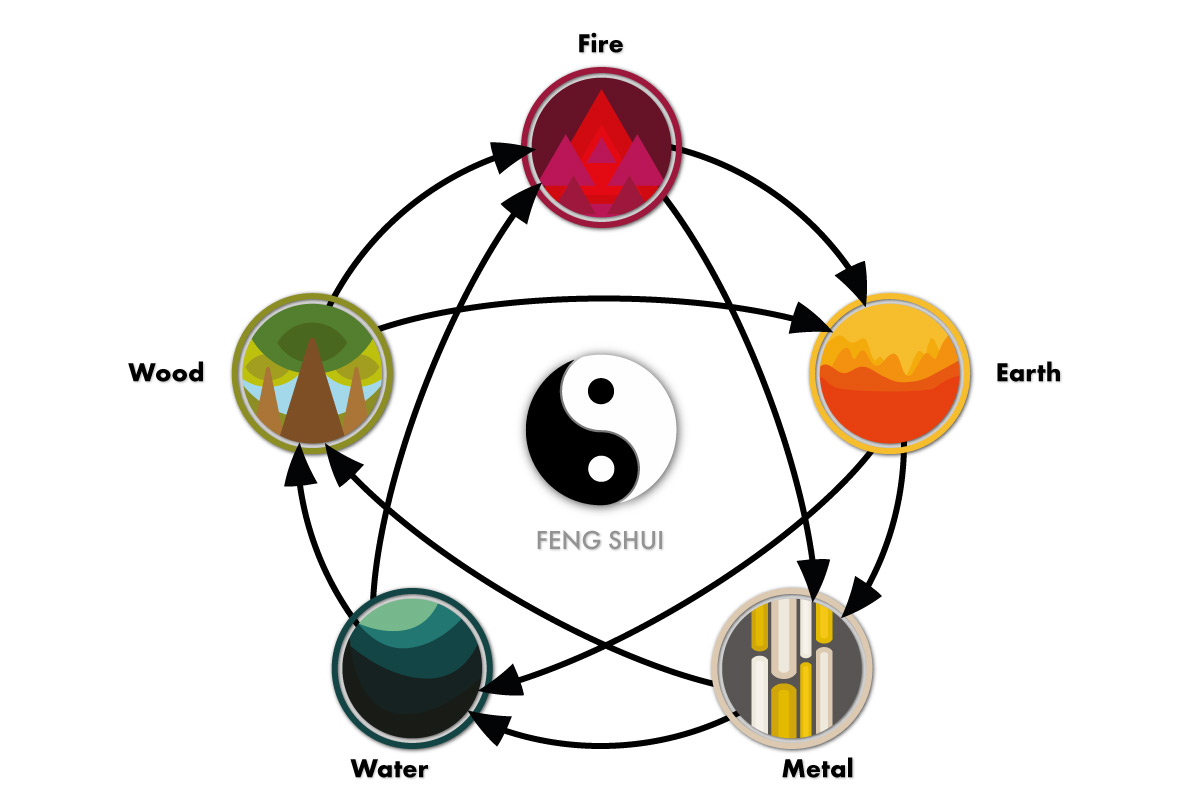
Originating from the Far East, specifically China, the science-art of Feng Shui is rediscovered by us every few years. It aims to create a positive flow of chi (qi) energy through appropriate interior design and the correct design of buildings. For those strongly rooted in Western tradition, we hasten to explain. Feng shui is mainly about the ergonomics of space and optimising it for human activities. What exactly is Feng Shui, why do we need this Chinese invention, and how can we benefit from it? We invite you to read on.
In Western culture, we always try to measure and count everything accurately. If we are unable to do so, we reject concepts that are incalculable to us. This is often the case with Feng Shui, the art of appropriately composing spaces in harmony with our life energy – chi.
The science of the Far East focuses on the tangible effects of actions taken regardless of whether we can trace the exact process. It does not matter what units we should use to measure chi energy and how to study its flows. Performing certain specific actions in our environment produces positive, reproducible effects, which are attributed to energy harmony and thus considered to be confirmed.
Our Western enquiries into the essence of reality tend to produce the same results, although they do so selectively. Psychology has a similar view of colours to that of Feng Shui. Architects, unaware of the recommendations of Feng Shui, situate windows and doors according to this philosophy. Architecture and Feng Shui, in general, go hand in hand, although they may not know anything about each other. We use optics to give the impression of more space, e.g. in shops, but also in small bathrooms, in the same way, no matter if we are inspired by our science or Feng Shui.
Literally translated, Feng Shui is fire and water. This refers to the concept of the elements, which we will discuss in a moment. It is similar in some ways to Aristotle's division, which operated until the development of modern chemistry.
It is necessary to understand that Feng Shui is not just the Feng Shui of a flat or the Feng Shui of a house, i.e. the art of interior design. What is crucial here is the energy flow, the movement of life energy chi, which takes place in our body but is not limited to it. Life energy is the energy of the world, and we are only one of the vessels for it.
We ought to arrange our space and our entire life according to Feng Shui principles. Feng shui ensures our well-being and, in addition to it:
and many, many other things.
No one can give us as much as Feng Shui promises, can they? The right furniture arrangement alone will not make us successful people. Creating a good environment removes obstacles and creates favourable conditions for our goals. Whether we succeed in this is still up to us. With Feng Shui, it will only get easier.
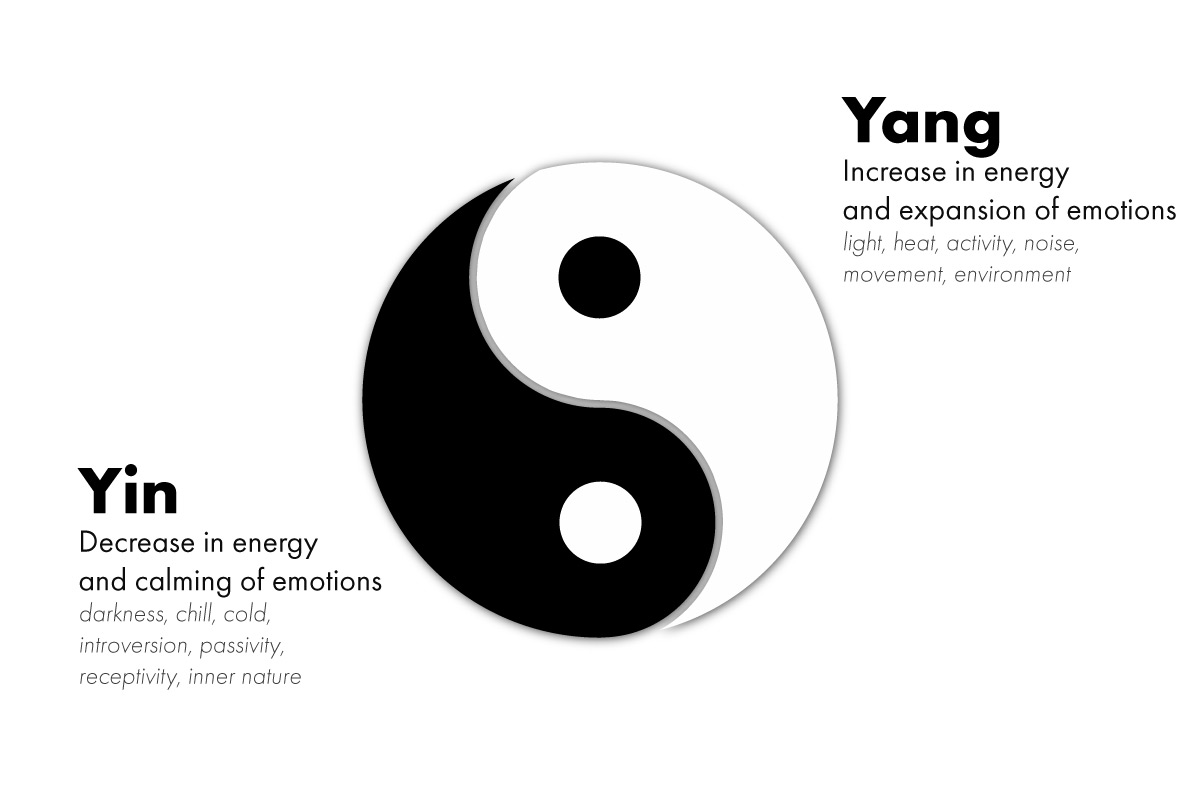
Good energy, which we control by applying Feng Shui rules, has been described since, on the banks of the Huang He, the first sage pondered the universe and man, a tiny crumb thrown to the wayside.
The good energy chi, described by Feng Shui, consists of two complementary energies: yin and yang. This Taoist concept is mainly recognisable by its distinctive symbol, associated with Taoism, as closely as we identify the cross with Christianity.
Even though yin and yang are opposing energies, we should not identify them simply with good and evil. This is our Western perspective. In Taoism, the opposing powers represent activity and passivity, development and stagnation, and the masculine and feminine elements. These elements complement each other, not fight each other. Even at their very centre, they have an island of their opposite. But what does this have to do with Feng Shui and interior design?
The complementarity of yin and yang possesses the ability to create. When a small ray of motivation appears in a dingy environment, it can burst into a vibrant flame, but it cannot burn forever. None of us can operate at maximum capacity all the time. That is why one form must transform into the next. Not necessarily immediately into its opposite since thrashing between extremes is never healthy. The desired resonance with chi is achieved when we move smoothly from form to form through all the intermediate stages.
This is where the concept of the five elements of Feng Shui comes in. They continually transform from one to the other, always in a specific order. Importantly, positive transformations must follow a strict pattern, which is among the fundamental principles of Feng Shui.
Deviating from the right path, rubbing up against the wrong elements, causes chi to dissipate.
Feng shui identifies 5 elements, each associated with different colours, shapes and cardinal directions. They require detailed explanation.

Fire is a dynamic transformation, a burst of creativity and an overwhelming will to act. It is associated with fame and success. The typical place for fire is the south wall of any building.
The natural colour of fire is red, but we must remember how intensive it is. Feng shui practices recommend that all walls in a room should never be red. When we have no choice, we break up the red with something else, preferably earthy.
Triangles and anything pointed interact with fire. The number 9 corresponds with this element.

The earth element refers to stability and security. We associate blissful happiness and family values with it. In the house plan, we will find it in the centre and the southwest and northeast regions.
Appropriate shapes for the earth are square and anything rectangular. As far as colours are concerned, browns and yellows are good choices. Orange is favourable, too.

Metal represents discipline. We should associate it with precision, order and elegance. In the house plan, it appears in the west and northwest. It also leans towards opulence.
The colours of metal are primarily white, silver and gold. They brighten and enlarge the space, although they can also make it feel slightly sterile.

Flexibility and intuition are associated with water. It is identified with peaceful renewal. We understand that everything flows, and the process is usually stable. Water is placed in the house plan on the north wall.
The elemental colours of the water are, of course, blue, but also black, which in Feng Shui philosophy symbolises calm, positive energy. The shapes that water prefers are all kinds of waves and zigzags. It corresponds with the numbers 1 and 6.

Growth, development and vitality combined with creativity is the meaning of the element of wood (or tree – depending on how we translate the Chinese term). The tree will dominate the east and southeast of our home.
The colours of wood are the colours of nature, primarily green and brown. The shapes of the wood are rectangle and anything with a vertical layout. When it comes to numbers, we focus on 3 and 4.
Right after the initial familiarisation with the Feng Shui elements, we notice the fluidity of transformations.
We can start anywhere. It is, after all, a circle. Let's choose fire. We have great energy for action, burst with enthusiasm and creativity, and throw ourselves into action. The fire dims, and we begin to reap its benefits. It is the ash that forms the earth. Fertile ash. In the ash, we also find that which has tempered in the fire.
The earth is safe and stable. It is a success that has arisen from the causality of fire. We realise and fulfil ourselves in it, slowly solidifying and settling.
Metal slowly emerges from the earth. The forms we have developed solidify in the metal. They are stable and lasting, but they can also mean stagnation. That is why water appears.
Water helps us to regain flexibility in the patterns we have created. It is a peaceful renewal, a moment of downtime, a time for regeneration. By going from element to element, we lose the remnants of the creative potential, which was seething in the fire phase. Water extinguishes past ambitions, making room for the growth of new ones.
From the water, new life is born in the form of the potential of wood. The wood is not creating yet – it is preparing for the act. It is developing, growing, exploring, and searching. It waits for a spark to burst forth with hidden potential. It yearns to ignite.
Reading the above description, we cannot help but feel how this pattern of growth, creation, development and rest is familiar to us. In Feng Shui, phases of calming down, attunement and enjoying achievements enjoy more emphasis than in our culture. All the differences boil down to priorities. We all understand that there is a time and place for everything, and this creates harmony, the fundament of Feng Shui.
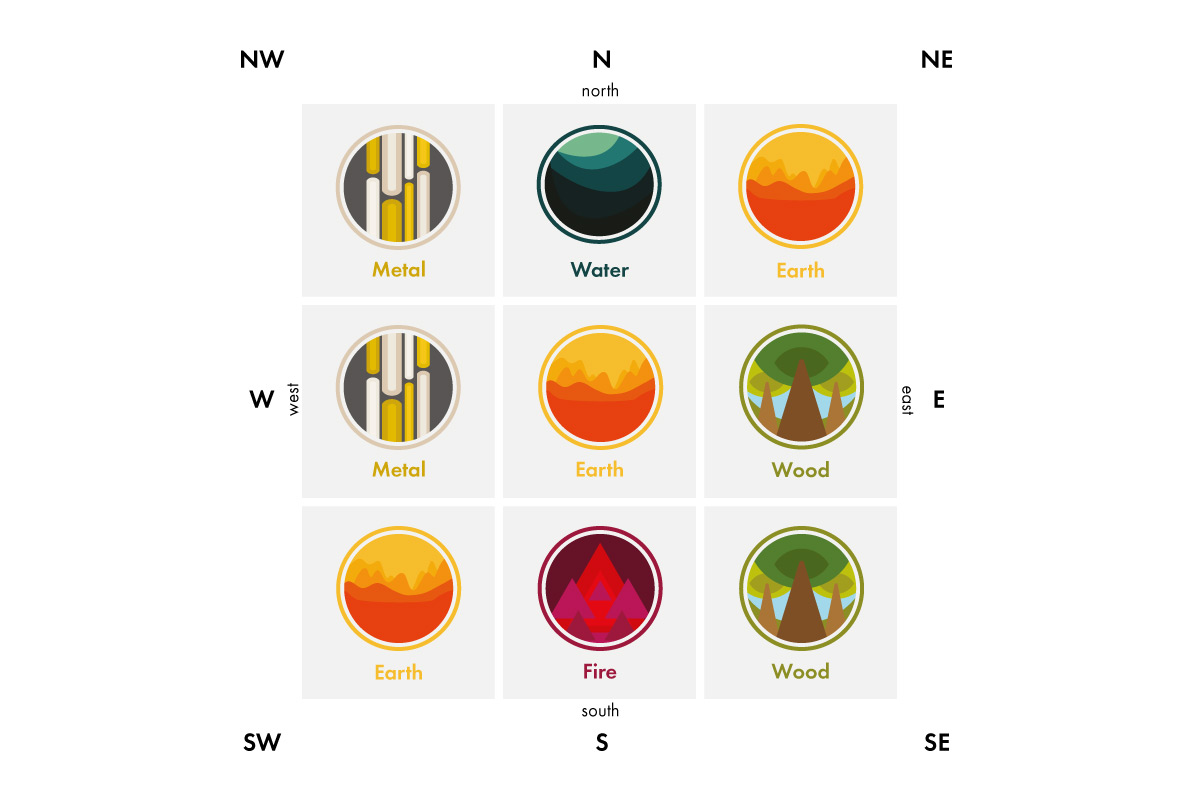
In the description of the elements, there has always been information about where each should appear concerning the cardinal directions. At stake here is the harmonisation of space. We used four cardinal directions, their intermediates, and the central point to define their placement. This approach coincides with one of the most fundamental Feng Shui concepts, the bagua grid, which we use to draw the loshu square.
The bagua grid should be plotted on the plan of our house or flat, positioned according to the world's directions, and with the entrance door in the middle of the north wall. By analysing the elements optimal in a given location, we can correlate such information with specific room functions, thus obtaining clues on how to plan the living space.
This is not the time or place to discuss exactly how to shape the chi currents in individual rooms of the house. Instead, let's address the general flow of chi energy and how it is affected by doors and windows. For now, all we know is the optimal location of the door and the direction of the front door.

As we already know, according to Feng Shui principles, doors are pivotal for chi distribution. The importance of the front door is considerable mainly because it is responsible for letting chi energy into the house. Once we let it in, we certainly do not want it to escape immediately. Therefore, doors and windows must not be in alignment. Too rapid penetration of our interior by vital energy will result in nervousness and instability.
According to Feng Shui, doors should be bright and must open outwards. We can achieve generous illumination by placing windows next to the door or using fanlights or glazing. Glass doors are also worth considering.
Good arrangement practices require that the door is never placed directly opposite the toilet. Lavatories poison the chi. When we can't do anything about it, we must keep the toilet door closed and preferably hang a mirror on them to neutralise their presence.
The shape and colour of the front door depend primarily on the side of the world it faces. The optimal facing is north, for which mainly wavy shapes and the colours blue and black are suitable.
In practice, we seldom have the opportunity to influence the direction of the exterior doors of a house or flat. Therefore, we should rely here on the general rules related to the zones of the loshu square and the shapes and colours suitable for the elements assigned to them.
Let's stress that we do not necessarily need a porthole inspired by a hobbit's cottage. Nor do we have to have triangular doors if they are set on the south (fire) wall. Instead, we can use various additions, overlays, glazing or fretwork, i.e. decorations. In this way, a plain rectangular door will adapt to Feng Shui. This is not a challenge because the wealth of options offered by EkoVitre or EkoGreen panels is so vast to ensure that everyone can create the perfect door for themselves.
Typically, the more windows, the better. Feng shui guidelines for windows traditionally begin with the statement that every household member should be able to observe the sky from any place in the house. The rule applies equally to other usable spaces. In practice, this means that according to Feng Shui, windows should be numerous but within reason. Opening them to all sides of the world is not advisable. In most cases, this is not feasible anyway.
Several further weak negative rules tell us what we should not do. Ignoring them can create so-called bad Feng Shui, i.e. energy flows that disrupt the desired phenomena. These are mainly:
Feng shui guidelines for windows are relatively flexible. It is more important to have access to the sky than to have it realised in a certain way. Especially since we often don't get to choose the direction of windows, having only one.
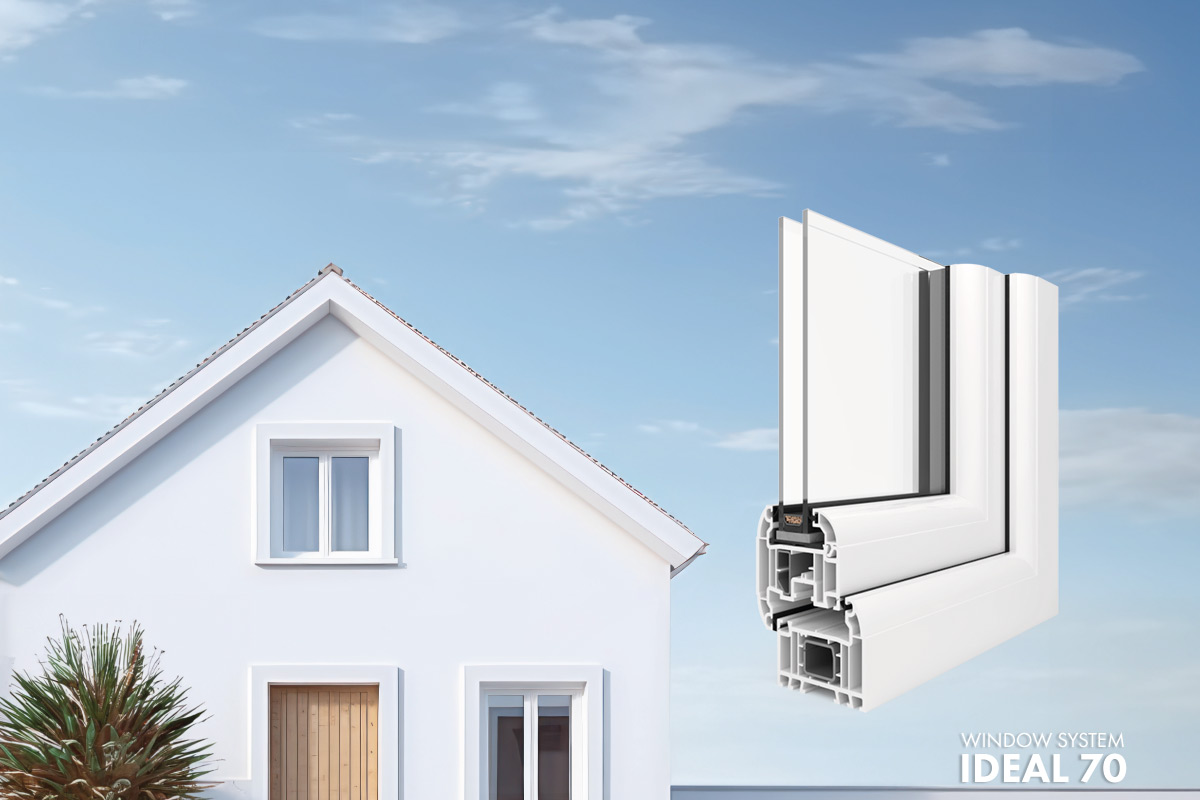
Like door shape, window shape is defined by its ornaments and finishes rather than the appearance of the window itself. In the case of windows, we have more room for manoeuvre because when we have, e.g., a blue room associated with the element of water, we can go for round windows or at least an arch.
The rectangle, the most popular and natural window shape, is also remarkably versatile. It is mainly associated with wood, but its stability and tranquillity can form the basis for all other zones of the loshu square, even for fire, which feeds on wood.
Architects and interior designers who follow Feng Shui philosophy are in luck. Most products on the market are uPVC windows with slightly rounded profiles as standard or an option. Since most windows relate to the element of water, curves and waves of uPVC match Feng Shui guidelines perfectly.
The water is also blue. Blue is a rather unusual window colour, granted, but brown or even anthracite, colours associated with wood, are easier to utilise. Let's also keep in mind that the typical white for windows is associated with metal. Metal can directly clash with wood and fire, so if we are planning plastic windows in the bedroom, a typical room for wood, we'd better go for wooden or at least veneered windows.
This short text, which only skims over the subject, certainly does not exhaust it. Let us conclude with a few more points that may prove very practical.
Ideals are, by definition, unattainable. Organising windows and doors strictly according to the principles of Feng Shui is almost impossible because of all the nuances that permeate on many levels.
The most important is to understand synergy and conflicts between elements. We need to remember, for example, that fire will devour a tree, which is fine if we want to expand fire. However, if we want to grow with the tree, we mustn't supplement it with fire. In contrast, we can replenish water with metal and earth and harm it with wood and fire.
When we cannot avoid conflicts, we are forced to use decorations like trinkets or utilise furniture blocking the harmful elements or promoting the desirable ones. The best way to get rid of what we don't want is through the mirror.
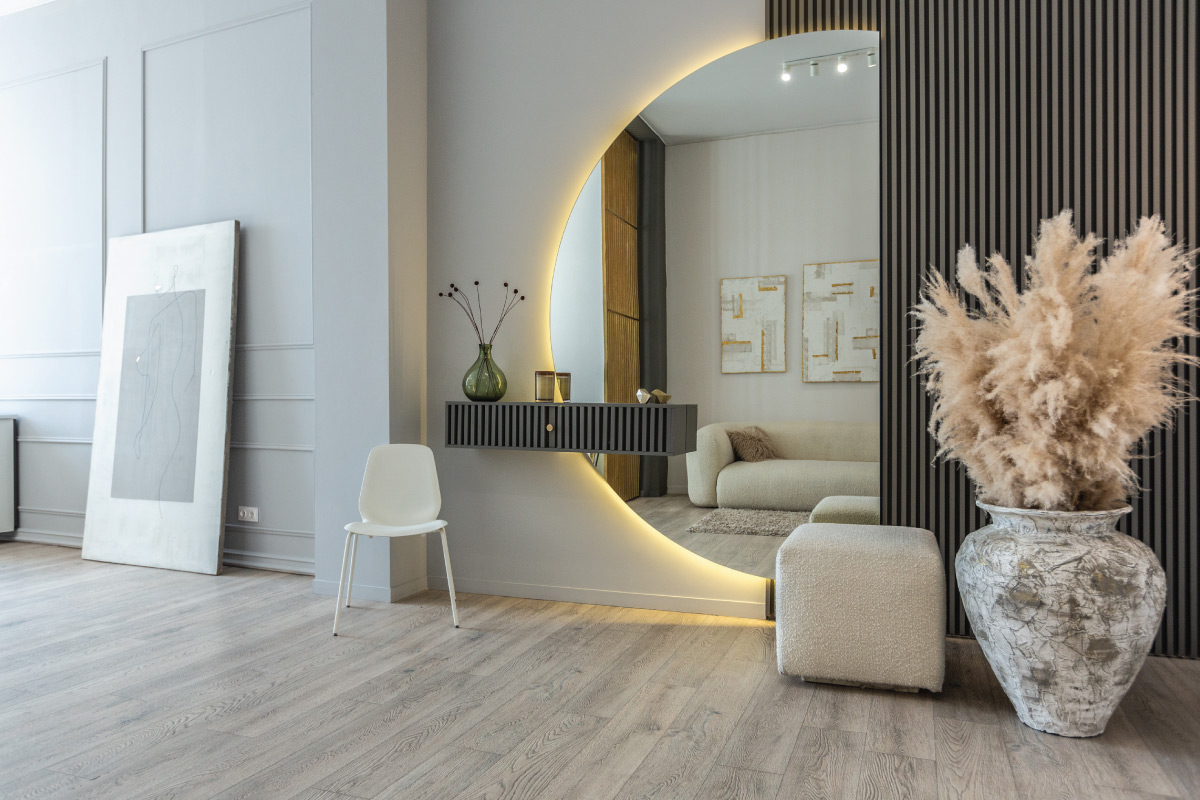
Windows are available in four, or strictly speaking, five options:
The fifth option is windows with aluminium overlays.
The choice of doors is similar:
To these, we can add:
which are, of course, not all glass, but their panels are mostly made of glass.
Each is associated with a particular element because of its construction material and finish. Our job is to think this through carefully and select the material for the room.

Metal windows and doors, i.e. products made of aluminium and steel, are considered the best gateways for energy. At the same time, however, they are representatives of metal, so they are not optimal for earth or fire spaces. On the other hand, when we need metal, we can use aluminium window overlays. Similarly, wood veneers work when we expect wood/tree.
When we want to go against the rules of Feng Shui for the sake of a higher good because, for example, harming one room will liberate another, we should use so-called remedies. These are additives that effectively remove barriers to the course of energy.
We have already mentioned mirrors as a way of blocking harmful factors. In addition to them, we use the following:
Art, in particular, offers enormous possibilities. Its impact depends on what it presents and its construction material, so we can achieve any effect using it.
Not everyone is a fan of Feng Shui. Sceptical people question the significance of things like the window and door ratio, which is expected to be 3:1, i.e. three windows for every door. Pursuing such goals seems like art for art's sake.
One can only agree with such an argument if we treat the whole thing in a Western way, fragmented and partial, focusing on individual aspects of Feng Shui. Like any Far Eastern concept, Feng Shui approaches the subject holistically. In this light, all principles of Feng Shui intertwine and complement each other. For every deviation, there is a remedy. For every dilemma, there are numerous solutions.
Feng Shui is a way of making a space functional and good-looking. It is based predominantly on common sense, controlling, for example, the amount of light in a given room or its heating and providing us with a compass rather than strict guidelines. This allows us to act in our way while achieving better results.
We wish you successful arrangements and recommend our products to them. The wide range and variety of available finishes make it easy to choose solutions that meet your requirements and, at the same time, guarantee your well-being through the correct flow of chi in the interior.

Hotline: +48 32 459 15 00 Contact for new business customers only. Connection fee in accordance with the operator`s price list.
E-mail: quoteuk@ekookna.com newclientuk@ekookna.com Contact for business customers only.
Eko-Okna S.A.
Kornice, ul. Spacerowa 4
47-480 Pietrowice Wielkie
NIP: 6391813241
KRS: 0000586067